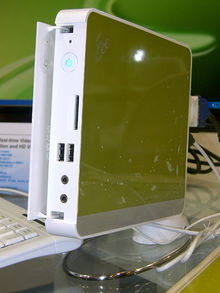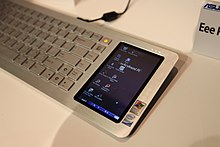Asus Eee

Asus Eee is a family of products by AsusTek Computer Inc. The product family began with the release of the Eee PC subnotebook in 2007; since then, the product family has diversified into a number of PC form factors. According to the company, the name Eee derives from "the three Es," an abbreviation of its advertising slogan for the device: "Easy to learn, Easy to work, Easy to play".[1]
Eee PC

The Asus Eee PC is a subnotebook/netbook computer. At the time of its introduction in fall 2007, it was noted for its combination of a light weight, Linux-based operating system, solid-state drive and relatively low cost. Newer models have added the option of the Windows 7 operating system, dual-core Intel Atom CPUs, and traditional hard disk drives, and have also increased in price, though they remain relatively inexpensive as laptops, and notably inexpensive for ultra-small laptops.
EeeBox PC
Asus EeeBox PC is a nettop (desktop for the internet) counterpart to the Asus Eee PC netbook (notebook for the internet).[2] Its motherboard employs Splashtop technology called "ExpressGate" by Asus.[3]
Eee Top

The Asus Eee Top is a touch screen computer designed by Asus and released in November 2008. Its motherboard employs Splashtop technology (an embedded Linux distribution) called "ExpressGate" by Asus.[4] Both models feature a 1.6 GHz Atom processor, widescreen (16:9) 15.6" display, 1 GB RAM, 160GB HDD, 802.11n Wi-Fi, speakers, SD card reader and a 1.3 MP webcam with Windows XP Home modified with Asus' big-icon Easy Mode.
Eee Keyboard
This section needs to be updated. (June 2016) |

ASUS Eee Keyboard contained a built-in PC motherboard within a full-size keyboard, similar to Cybernet's keyboard computer models and reminiscent of such 1980s PCs as the ZX Spectrum, Commodore 64, and Atari ST. It substituted a touchscreen in place of the conventional numeric keypad. ASUS had planned to ship the device in September 2009, but it actually debuted at CeBIT 2010 and launched in March 2010.[5]
The ASUS Eee Keyboard EK1542 contained a standard set of features typical for 2008 netbooks: an Intel Atom N270 processor (2.5WTDP), built around the Intel 945GSE chipset (6W TDP) and a ICH7-M South bridge (3.3W TDP 3.3). A Mobile Intel 945GSE Express chipset integrated into the Intel GMA 950 video subsystem resulted in performance similar to the Asus EEE PCs 901/1000.
The computer came with Windows XP Home Edition; an additional 1 GB RAM, as well as a 16 or 32GB Solid State Drive, was soldered directly to the motherboard (preventing any memory upgrade). Network interfaces consisted of a standard gigabit LAN adapter, Wi-Fi 802.11b/g/n @2.4GHz, and Bluetooth. A Realtek sound system drove 2 small built-in speakers, and a Li-Po accumulator provided a power capacity of 49 W*h.
It boasted some unique features: a 5-inch, 800x480 screen with a multi-touch panel, a Broadcom video decoder for accelerating H.264 and VC-1 high-definition compression algorithms, and a Wireless 720p Video Transmitting function utilizing Ultra-wideband Technology (a minicard receiver connecting to a TV/monitor via HDMI).
Eee Stick

The Eee Stick is an accessory that is expected to be bundled with specific models of the Eee PC and EeeBox PC. These specific models will also come with games that will take advantage of the features of this hardware. This accessory is very similar to the Wii Remote. The device takes two AA batteries in each of the two components (four batteries in total).
Eee PC Media Server
Asus Eee PC Media Server was shown at CES 2009.
Eee Pad MeMO
Asus MeMO 171 tablet was displayed at CES 2011,[6] while MeMO 370T was displayed at CES 2012 [7]
- Eee Pad MeMO 171 - 1280x800 pixel 7" screen, powered by Qualcomm 8260 Dual-core CPU 1.2 GHz, and Android 3.2 Honeycomb;[8] for US$600, available only in Asia.
- Eee Pad MeMO 370T - 1280x800 pixel 7" screen, powered by the 4-core Tegra 3, and Android 4.1 Jelly Bean; 16GB for US$249 (pre-tax).
Eee Pad and Eee Reader
Asus showed previews of a dual-touchscreen "Flipbook" notebook at Cebit 2009 in Germany.[9] The company stated that the Flipbook possessed the capability of optionally displaying user interface elements in both screens both horizontally and vertically; the concept design was renamed as the "Eee Reader", rebranded as an e-book reader, and scheduled for launch in Q4 2009,[10] which did not happen as intended. Finally, the Eee Reader was rebranded again as the "Eee Book" and scheduled for launch at the June 2010 Computex Taipei.
In addition, Asus disclosed to the press in January 2010 that a tablet computer named as "Eee Pad", using an Nvidia Tegra 2 chip, a 3G wireless connection and a 720p or 1080p resolution, would also debut at Computex.[11] It finally materialized in March 2011 as the Eee Pad Transformer (TF101) which has an optional real (hardware) keyboard that can be connected to it. This was then Succeeded by the Asus Eee Pad Transformer Prime in December 2011.
In 2012 the newest version was released, the Asus Transformer Pad Infinity.
Eee Note
Originally released in Taiwan, featuring stand-alone note-taking/sketching capability and an E-reader. Its non-backlit screen had a long battery life, and incorporated a Wacom tablet with pressure sensitivity allowing pen-drawing on PC when connected with a micro-USB cable.
EeeBook
The Asus EeeBook is a lineup of affordable Windows laptops by Asus. In 2014 Asus introduced EeeBook lineup of computers starting with the X205TA model. By 2017 the EeeBook lineup was succeeded by the Asus VivoBook E Series. Some EeeBook laptops were rebranded to VivoBook E Series laptops such as the EeeBook E202 was rebranded to the VivoBook E202 and the EeeBook E402 to the VivoBook E402. The EeeBook lineup consists of the E202 (E202SA), E402 (E402MA), E502 (E502SA and E502MA) and X205 (X205TA).
References
- ^ "ASUS Eee PC". Asus. 2008. Archived from the original on 2008-04-09. Retrieved 2008-04-10.
- ^ "ASUS Debuts Desktop-Equivalent Eee PC". PC Magazine. 2 June 2008.
- ^ Anand Lal Shimpi (3 June 2008). "ASUS Eee Box Preview & Intel's Atom Benchmarked". AnandTech.
- ^ "14-Oct-2008 review by CNet". Archived from the original on 2009-02-09. Retrieved 2009-01-10.
- ^ "ASUS Eee Keyboard PC officially launched (at last)". newatlas.com. Retrieved 2017-03-19.
- ^ ASUS MeMO CES 2011 -Youtube
- ^ "Asus MeMo returns to CES with a low price and two more cores". Archived from the original on 2012-02-02. Retrieved 2012-03-14.
- ^ Eee Pad MeMO 171 specifications
- ^ ASUS Flipbook from physorg.com
- ^ Tech news: For the smarter kind of bookworm
- ^ Asustek Plans Eee Book E-reader and Tablet PC to Rival IPad Archived February 9, 2010, at the Wayback Machine, PC World
